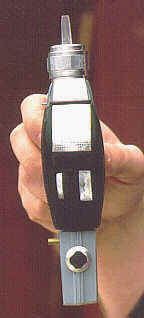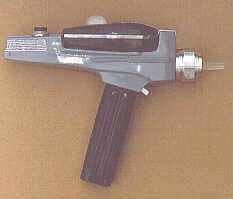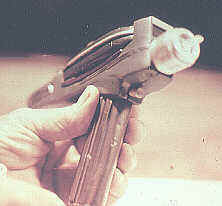The Classic Star Trek Phasers
Part two.. The 2nd Season Page 3
By Richard A. Coyle
 Right
below the top cap and to the rear of the muzzle on the left side (just to be
sure we all are talking about the "same left side", left and right
is determined by holding a weapon in your hand (either hand is OK), muzzle of
the gun pointed away from you, then the side that is on your left is the left
side and the side that is on your right is the right side) is a detail that
looks like a knob in/on the left side of the main body. This has become known
as the dilithium cap although there is no evidence that it was ever called that
on the show.
Right
below the top cap and to the rear of the muzzle on the left side (just to be
sure we all are talking about the "same left side", left and right
is determined by holding a weapon in your hand (either hand is OK), muzzle of
the gun pointed away from you, then the side that is on your left is the left
side and the side that is on your right is the right side) is a detail that
looks like a knob in/on the left side of the main body. This has become known
as the dilithium cap although there is no evidence that it was ever called that
on the show.
I have couple of shots that show , the side cap was simply a flat
section cut off a round aluminum rod that had several cuts crossing the face,
leaving a small thin section across the front forming a small bar that looks
like a knob. This also appears to have simply been glued on. Other models would
have a more complex three part knob that were made and placed within a hole drilled into the side of the body. There are three styles of these little details.
The first one I told you about in the last paragraph, the other two are nearly
identical. They are made up of three parts. The first is center which was a
cut off section from a round aluminum rod (again) with a V cut into one end
that had a small hand made bar shaped to make the center knob that sat into
the V cut. There were two styles of this model, one with thin wall tubing and
one with a thicker tubing.
drilled into the side of the body. There are three styles of these little details.
The first one I told you about in the last paragraph, the other two are nearly
identical. They are made up of three parts. The first is center which was a
cut off section from a round aluminum rod (again) with a V cut into one end
that had a small hand made bar shaped to make the center knob that sat into
the V cut. There were two styles of this model, one with thin wall tubing and
one with a thicker tubing.
I believe it was Franz Joseph who called this part the
dilithium crystal cap in his book "The Star Trek Technical Manual". On some of
the "hero" models this knob was hooked to a five position switch and it would
snap loudly into each of the five settings. On the dummies most of them were just glued
in.
 Just above this knob were three ribs that are raised on the side of the body.
These were the same color as the main body. Below this knob we see the trigger.
This part was many shapes, sizes and placed in several angles. One constant
was that all were aluminum.
Just above this knob were three ribs that are raised on the side of the body.
These were the same color as the main body. Below this knob we see the trigger.
This part was many shapes, sizes and placed in several angles. One constant
was that all were aluminum.
Inside the working models the propmakers made their own home-grown switch with the aluminum button fastened to a brass bar to give
it the spring back ability which, when pressed back, would made contact with
another brass bar that made the electrical connection to light the tip bulb.
(I would have bought a pushbutton at the store. Possible there were few switches
small to enough to fit back then, I don't know.) The trigger is mounted in a
small housing that seems to have been tacked onto the main body to both hold
the trigger and to allow mounting the handle to the main body. Below this section
is indeed the handle.
own home-grown switch with the aluminum button fastened to a brass bar to give
it the spring back ability which, when pressed back, would made contact with
another brass bar that made the electrical connection to light the tip bulb.
(I would have bought a pushbutton at the store. Possible there were few switches
small to enough to fit back then, I don't know.) The trigger is mounted in a
small housing that seems to have been tacked onto the main body to both hold
the trigger and to allow mounting the handle to the main body. Below this section
is indeed the handle.









